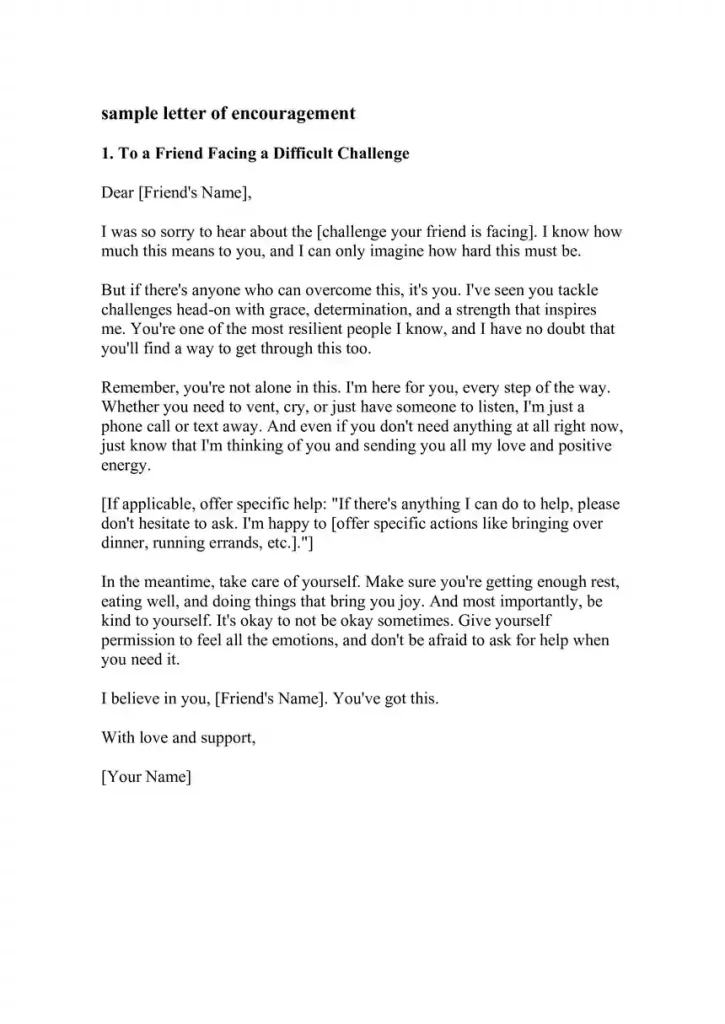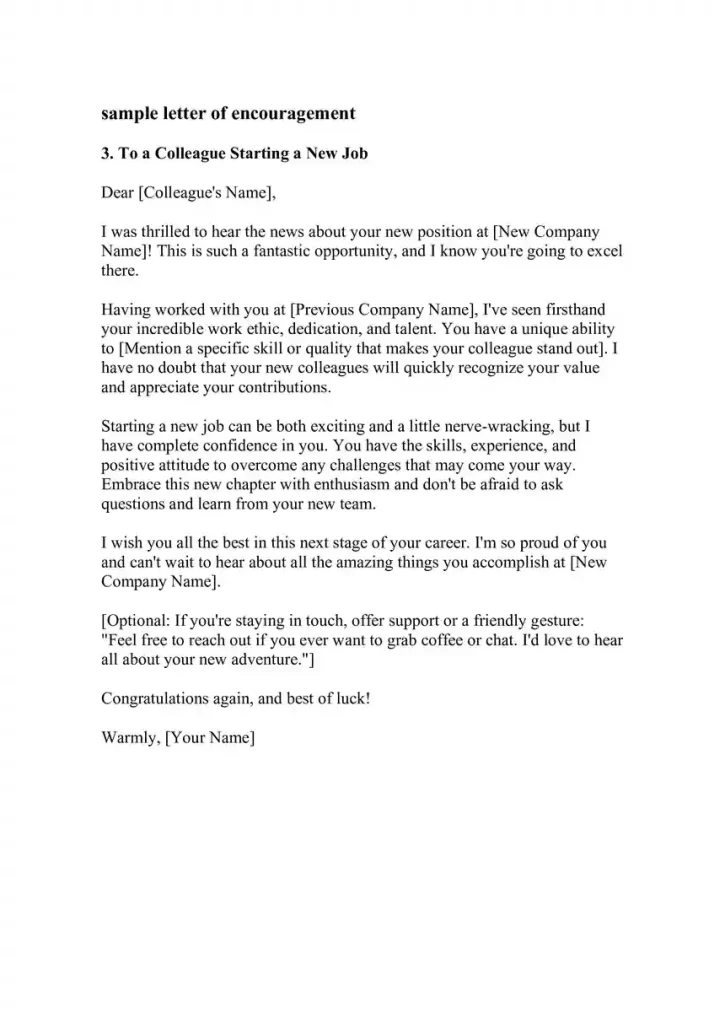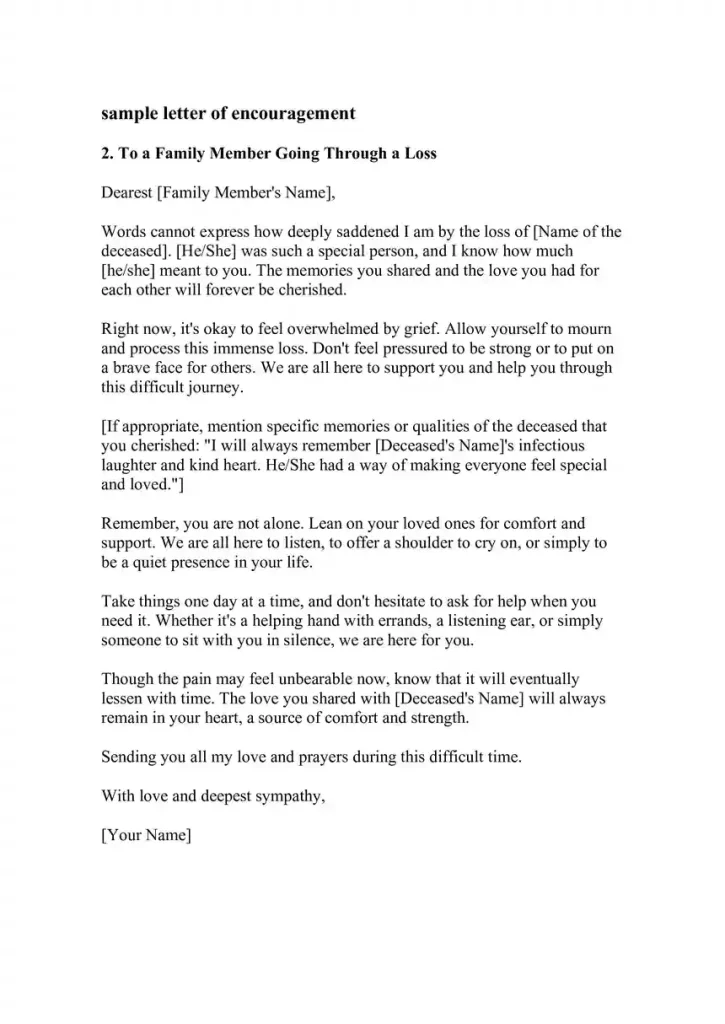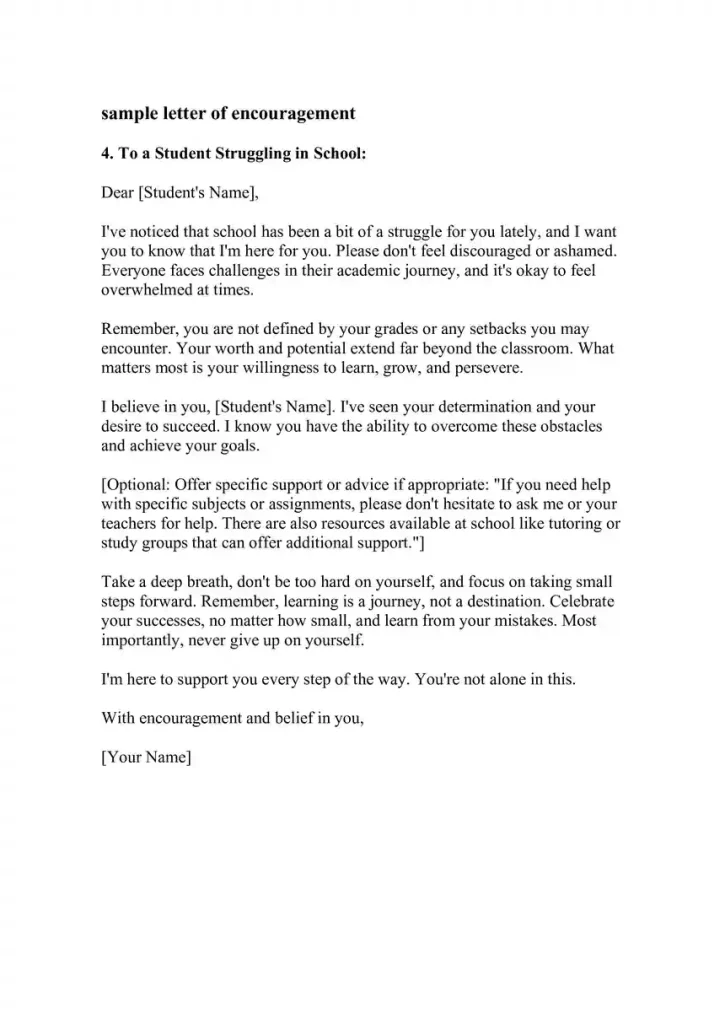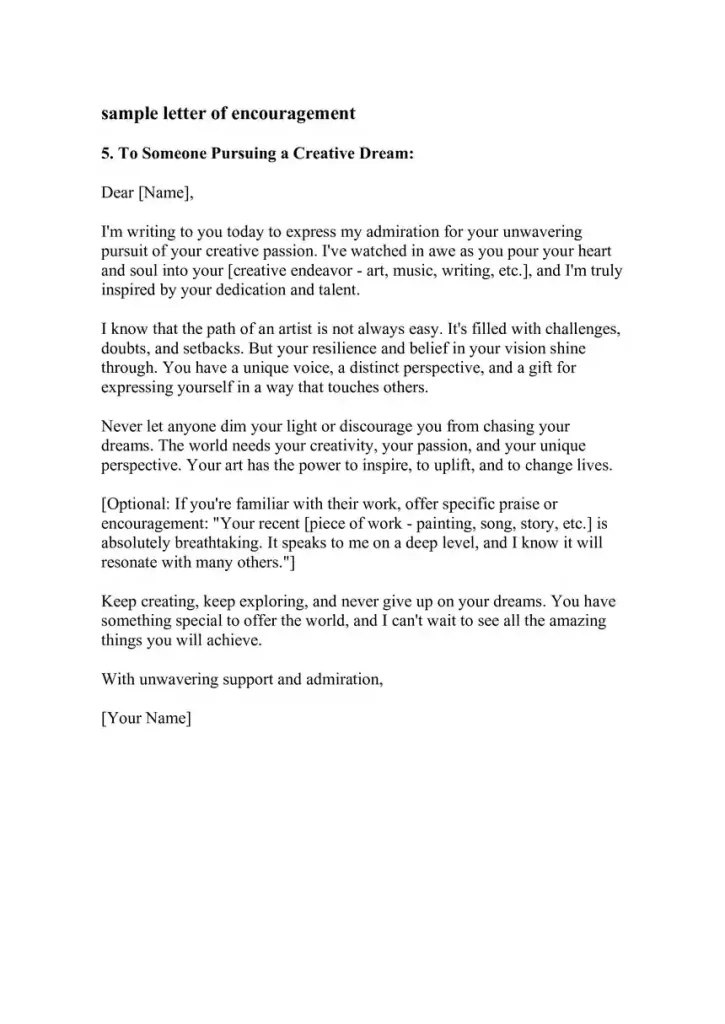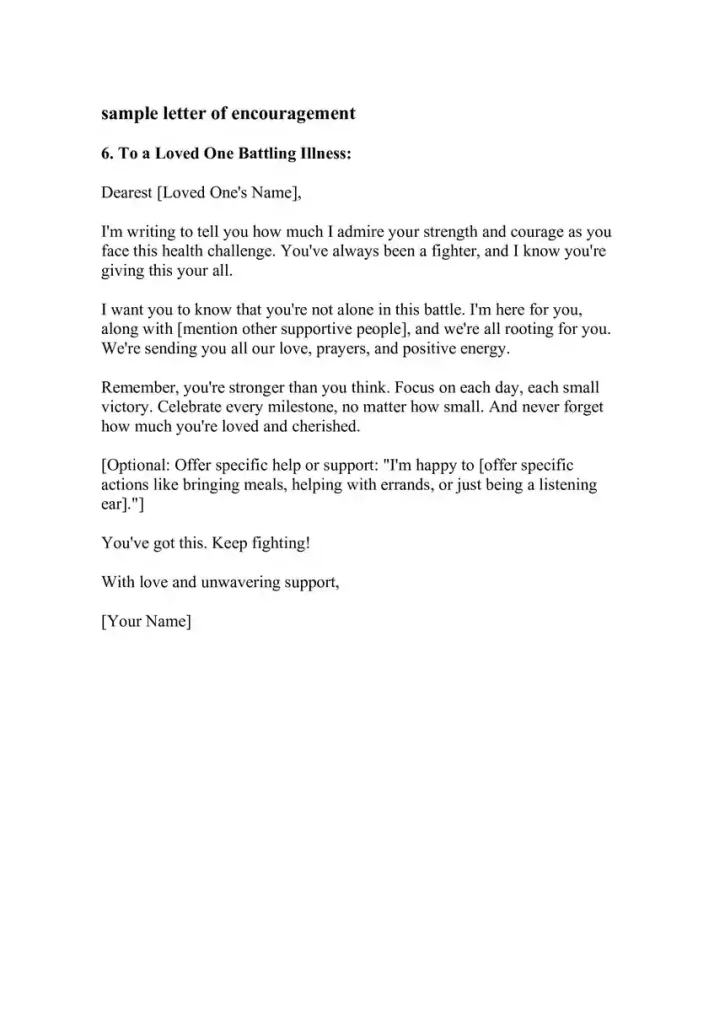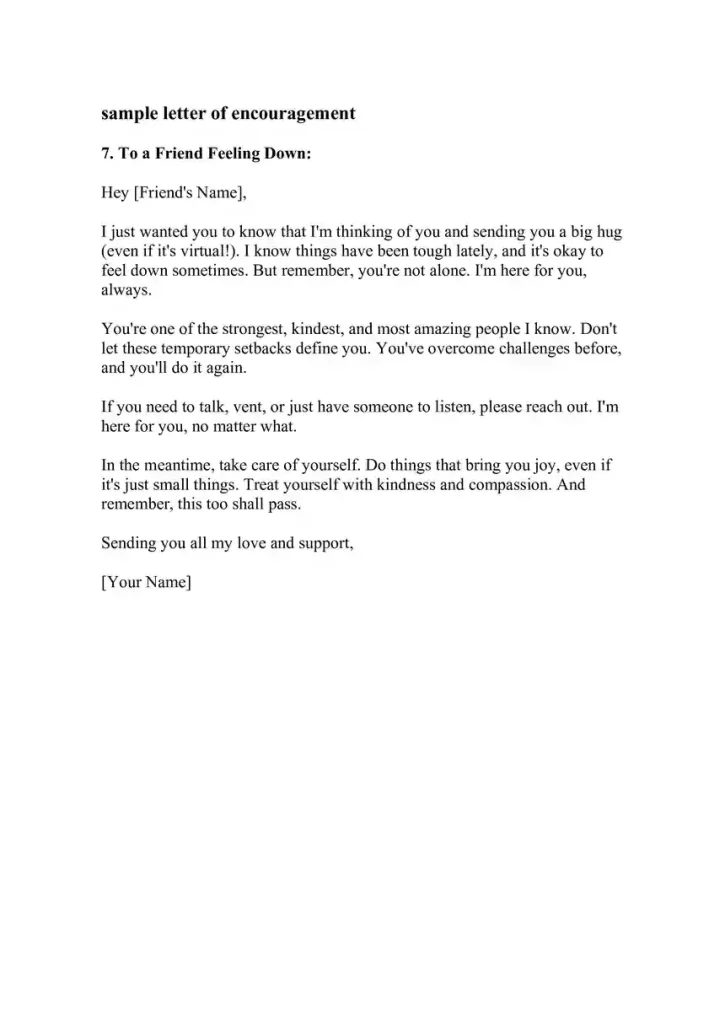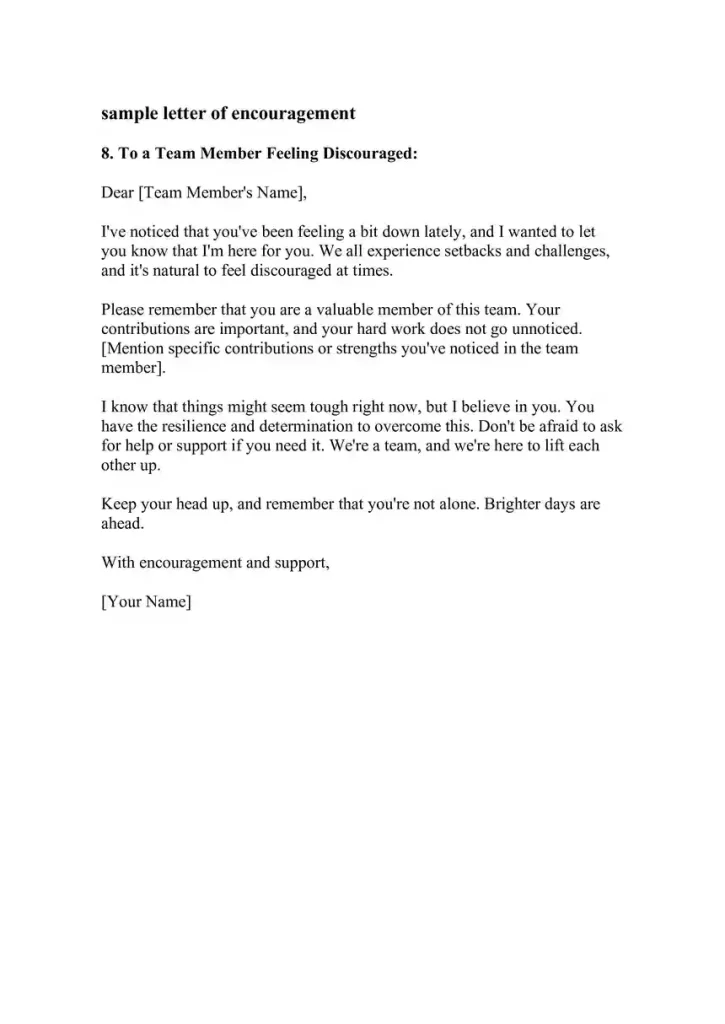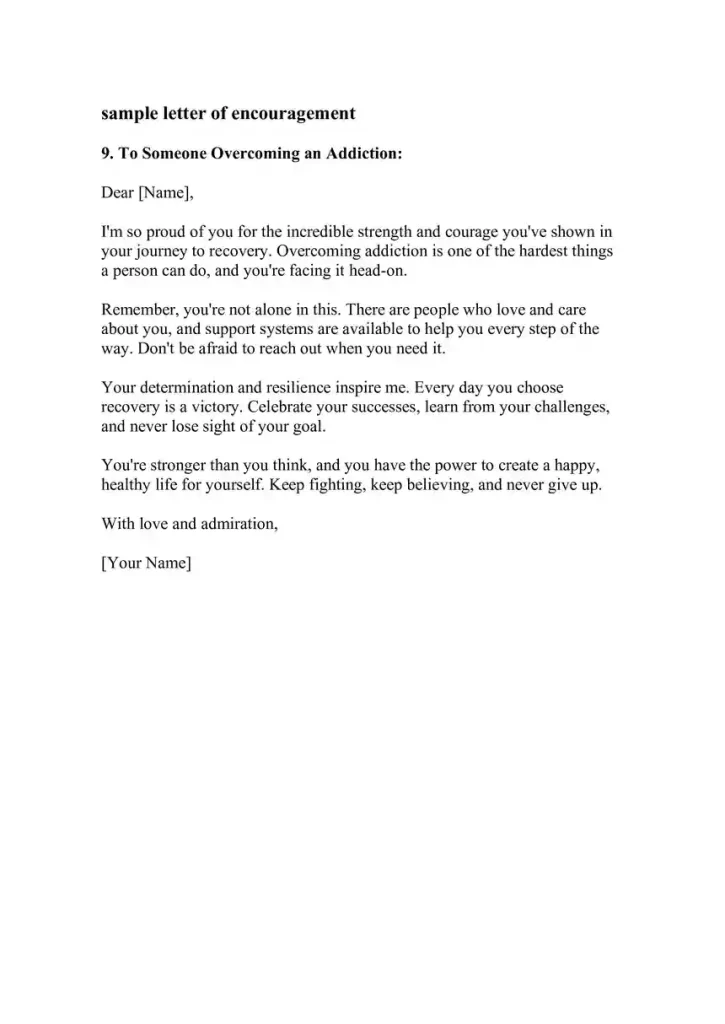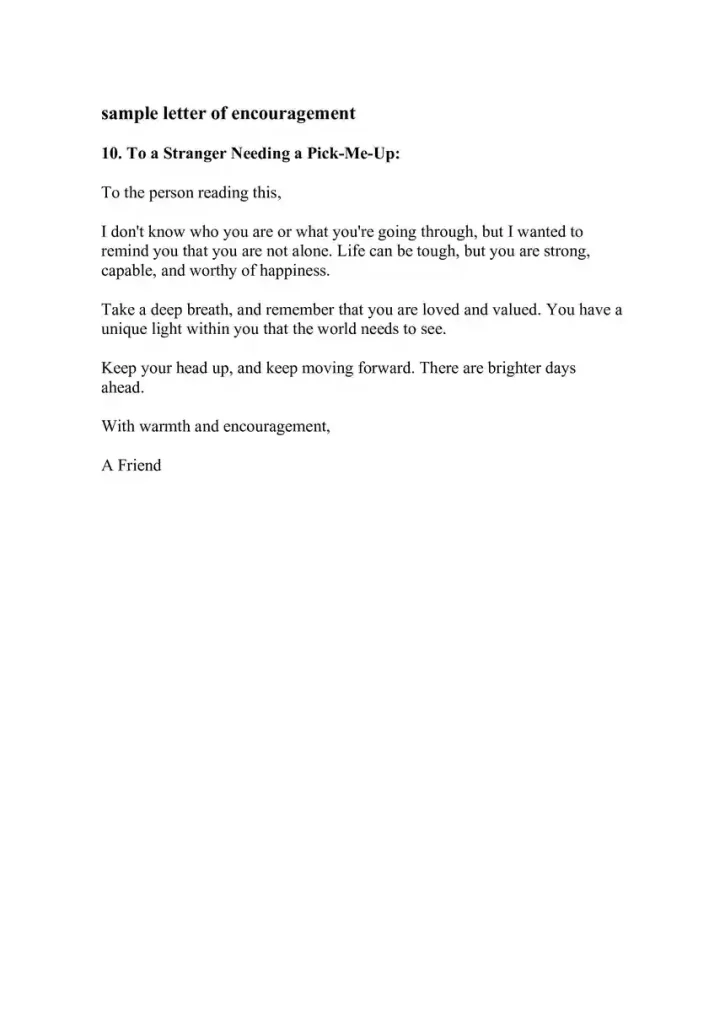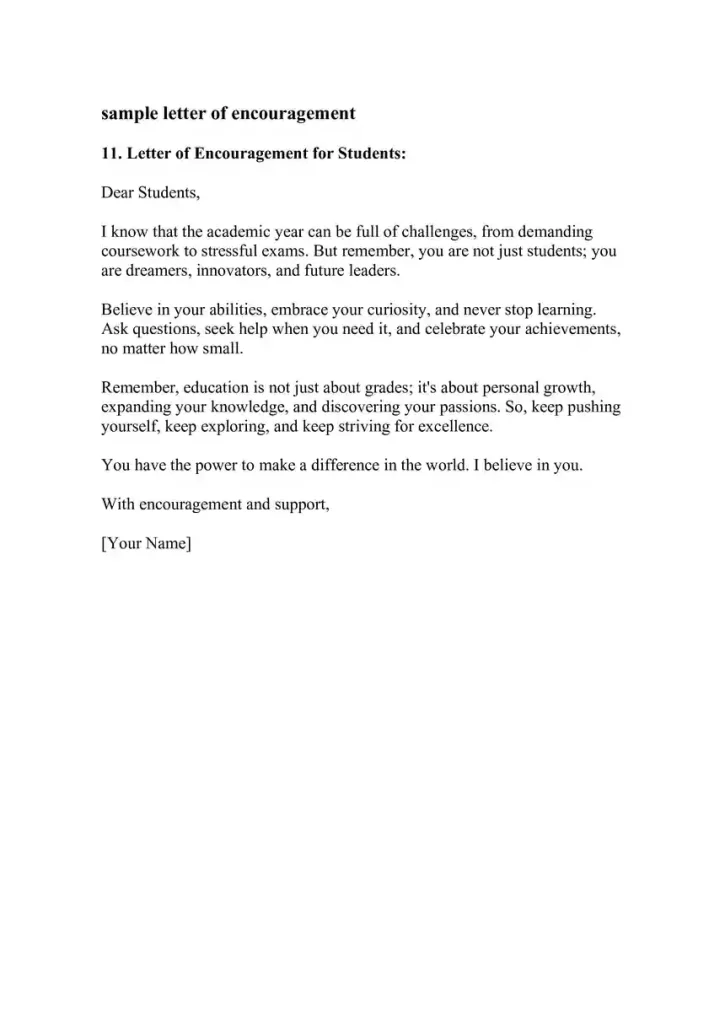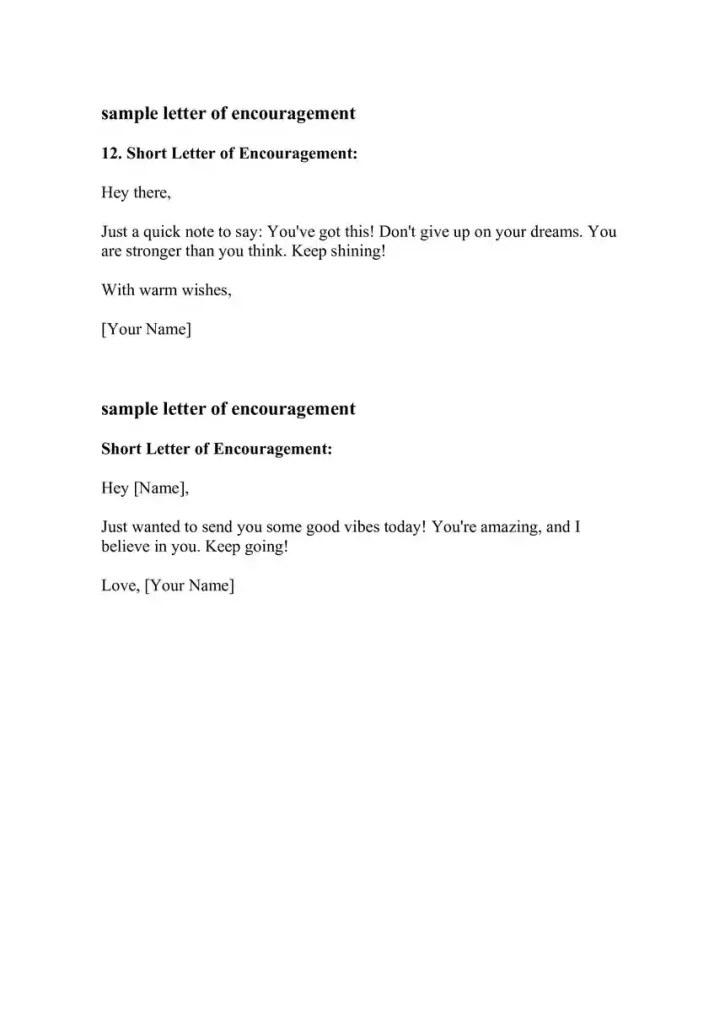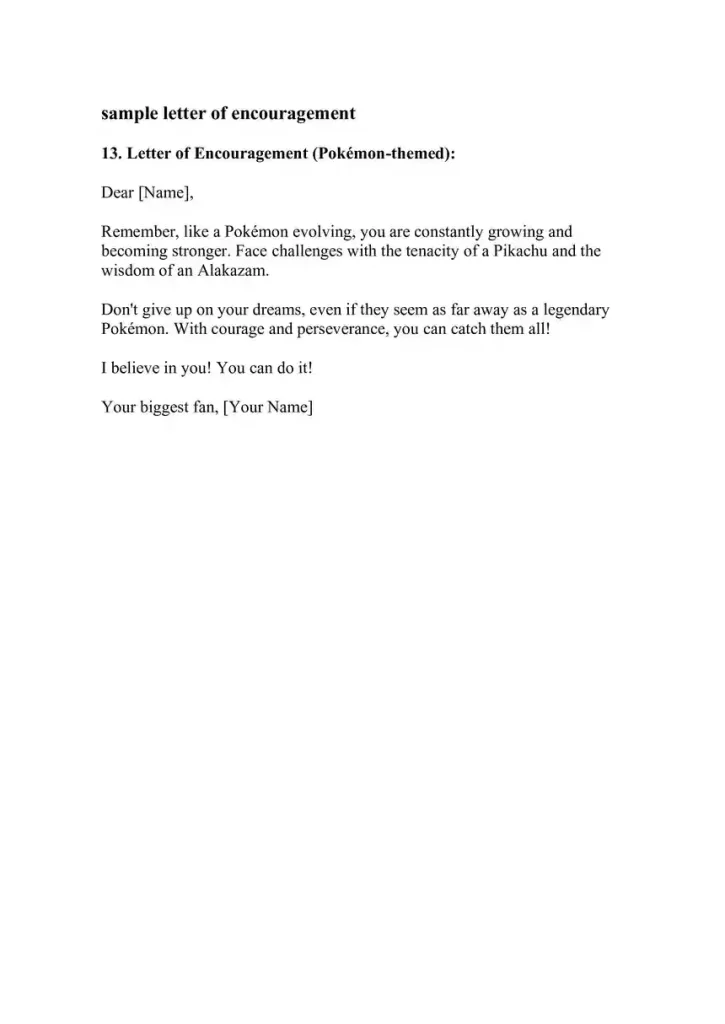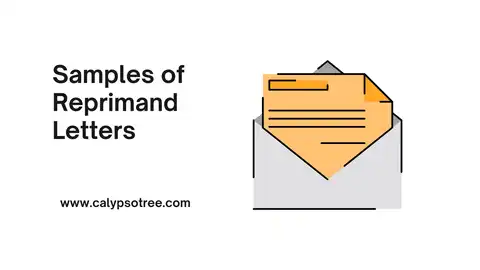An example letter of encouragement is a heartfelt note meant to uplift and motivate someone. It can make a big difference in someone’s life. This article will show you how to write a great letter of encouragement. Whether you write to a friend, family member, or colleague, you will find helpful tips and examples here.
What is a letter of encouragement?
It is a written note that helps lift someone’s spirits and motivate them during tough times or important events.
Recipients of a Letter of Encouragement
You can write letters of encouragement to:
Friends and Family
Writing a letter of encouragement to friends and family is exceptional. These are the people you care about the most. Your kind words can make a big difference when they face hard times. You can cheer them up and remind them they are loved and supported.
Colleagues and Employees
In a work setting, encouraging letters can boost morale. If a colleague or employee is struggling with a project or feeling down, a supportive note can help. It shows that you notice their efforts and believe in their abilities.
Students and Mentees
Students and mentees often need encouragement. They might be facing exams, new challenges, or personal struggles. Your letter can inspire them to keep trying and not give up, making them feel more confident and capable.
Community Members
Community members can also benefit from encouragement. This could be someone in your neighborhood, a member of a club, or anyone else in your community. A kind letter can unite people and create a sense of support and unity.
Key Elements of a Letter of Encouragement
A good letter of encouragement should have the following:
Positive Tone and Uplifting Language
A good letter of encouragement should always have a positive tone. Use uplifting language to make the reader feel better. Avoid negative words. Focus on the good things and the person’s strengths.
Example: “You are doing a great job! Keep up the hard work, and you will succeed.”
Personal Anecdotes and Shared Experiences
Adding personal anecdotes or shared experiences makes your letter more meaningful. It shows that you understand what the person is going through. Sharing a story where you faced a similar challenge can be very helpful.
Example: “I remember when I had to face a similar situation. It was tough, but I got through it by staying positive and asking for help when needed.”
Specific Encouragement and Support
Be specific in your encouragement. Mention the things the person is doing well and offer your support. This shows that you are paying attention and genuinely care.
Example: “I see how hard you are working on this project. Your dedication is amazing. If you need any help, please let me know. I am here for you.”
When to Write a Letter of Encouragement
Situations That Call for Encouragement
There are many times when someone might need a letter of encouragement. Here are some everyday situations:
- Exams: When someone has an important test, they might feel stressed. A letter can help them feel more confident and less worried. Example: “Good luck on your exams! I know you have studied hard, and you are going to do great. Believe in yourself!”
- Personal Struggles: A letter can provide comfort and support if someone is going through a tough time, like a loss or a difficult situation. Example: “I know things are tough right now. Remember, you are not alone. I am here for you; you are stronger than you think.”
- New Ventures: Starting something new, like a new job or project, can be scary. Encouraging words can boost their confidence. Example: “Congratulations on your new job! I know you will do amazing things. Believe in yourself and enjoy this new adventure.”
Timing and Relevance of Sending the Letter
It’s essential to send your letter at the right time. Here are some tips on timing and making your letter relevant:
- Before a Big Event: Send your letter before the person faces their challenge. This way, they can read it and feel encouraged when needed. Example: “Good luck with your presentation tomorrow! You have prepared well, and I know you will do a fantastic job.”
- During Tough Times: If someone is struggling, send your letter when they are going through the hard part. Your words can provide comfort and hope. Example: “I know you are having a tough week. Just remember that you are capable and strong. This tough time will pass.”
- After a Setback: If the person has faced a disappointment or failure, send a letter to lift their spirits and encourage them to try again. Example: “I know you are disappointed about not getting the job. But remember, you are talented, and opportunities will come. Keep your head up and stay positive.”
Your words will have the most impact if you choose the right time and make sure your letter is relevant to what the person is experiencing. Your letter can be a source of strength and encouragement exactly when they need it the most.
Why Should You Write a Letter of Encouragement?
To Show You Care
Writing a letter of encouragement shows that you care about the person. It lets them know you are thinking of them and want to help. Your kind words can make them feel loved and supported.
To Help Them Feel Better
A letter of encouragement can help someone feel better when they are sad or stressed. Your positive words can lift their spirits and make them feel more hopeful. It reminds them that they are not alone and that someone believes in them.
To Motivate Them
Encouraging letters can motivate someone to keep going. Your words can inspire them to try harder and not give up. They can also remind them of their strengths and abilities, helping them feel more confident.
Types of Letters of Encouragement
Professional vs. Personal Letters
- Professional Letters: These letters are written in a work or school setting. They are usually more formal. You might write a professional letter to a coworker, employee, or student. Example: “I noticed your hard work on the recent project. Your dedication and effort are impressive. Keep up the great work!”
- Personal Letters: These letters are written to friends or family members. They are usually more casual and warm. For example, you might write a personal letter to a friend who is having a tough time. Example: “Hey, I know things have been tough lately. Remember, you are strong and capable. I am here for you always.”
Short Notes vs. Detailed Letters
- Short Notes: These are quick and to the point. A brief note can be a few sentences or a paragraph. It’s great for a quick boost. Example: “You’ve got this! I believe in you!”
- Detailed Letters: These are longer and more in-depth. A detailed letter can be a few paragraphs to a full page. It’s great for more severe situations where more support is needed. Example: “I know you are facing a big challenge right now. Remember the time we faced a tough situation together? We got through it by staying positive and supporting each other. You have the strength to get through this, too. I’m here for you.”
Handwritten vs. Digital Letters
- Handwritten Letters: These are written by hand and sent by mail. Handwritten letters can feel very personal and unique. They show that you took the time to write and send them. Example: Write a note on a lovely card and mail it to your friend.
- Digital Letters: These are sent by email or through a digital message. They are quick and easy to send and can be great for instant encouragement. Example: Sending an encouraging email to a coworker.
By understanding the different types of letters and their benefits, you can choose the best way to support and encourage the people in your life.
Example Letter of Encouragement
Here’s an example:
Dear Sarah,
I know things have been tough lately. But remember, you are strong and capable. Every challenge you face is an opportunity to grow. Believe in yourself and keep pushing forward. You have my full support and love.
Warm regards, Alex
Example letter of encouragement to a friend
Example Letter of Encouragement To a Colleague Starting a New Job
Example Letter of Encouragement To a Family Member Going Through a Loss
Example Letter of Encouragement To a Student Struggling in School
Example Letter of Encouragement To Someone Pursuing a Creative Dream
Example Letter of Encouragement To a Loved One Battling Illness
Example Letter of Encouragement To a Friend Feeling Down
Example Letter of Encouragement To a Team Member Feeling Discouraged
Example Letter of Encouragement To Someone Overcoming an Addiction
Example Letter of Encouragement To a Stranger Needing a Pick Me Up
Example Letter of Encouragement for students
Short Letter of Encouragement Example
Example Letter of Encouragement Pokemon
Length and Tone of a Letter of Encouragement
Ideal Length for Different Scenarios
The length of a letter of encouragement can vary depending on the situation. Here are some guidelines:
- Short Notes: Sometimes, a brief note is enough. A few sentences or a paragraph can quickly show your support. This is great for quick boosts, like before a test or a big event. Example: “Good luck on your test today! I know you’ll do great. Remember to stay calm and believe in yourself!”
- Detailed Letters: For more significant challenges, a longer letter is better. This gives you more space to share stories, advice, and support. A detailed letter can be a few paragraphs to a full page. Example: “I know you’re going through a tough time. Remember when we faced that big challenge together? We got through it by staying positive and helping each other. You are strong, and you can overcome this, too. I’m here for you every step of the way.”
Maintaining an Appropriate Tone
The tone of your letter should always be positive and supportive. Here are some tips to keep the right tone:
- Be Positive: Focus on the good things and the person’s strengths. Avoid negative words or criticism. Example: “You have so much talent and determination. I believe in you!”
- Be Supportive: Show that you care and are there for them. Use words that express your support and willingness to help. Example: “I’m here for you and support you no matter what.”
- Be Personal: Make the letter personal by mentioning shared experiences or specific details. This makes the letter more meaningful. Example: “Remember our trip last year? We faced many challenges, but we had fun and made it through. You can handle this too!”
Methods of Sending a Letter of Encouragement
Traditional Mail
Sending a letter by traditional mail can be very special. It shows you took the time to write, buy a stamp, and mail it. Receiving a physical letter can be very touching and memorable.
- Pros: Personal touch, can be kept as a memento
- Cons: Takes longer to arrive, requires postage
Email and Digital Formats
Sending a letter by email or digital format is fast and convenient. You can send your encouragement instantly, and it’s easy to read on any device.
- Pros: Quick delivery, easy to send and read
- Cons: Less personal, can be overlooked in a crowded inbox
Choosing the Best Method for Your Recipient
Think about what the recipient would appreciate the most. If they love getting mail, send a traditional letter. If they prefer quick communication, an email might be better. Consider their preferences and what will make them feel the most supported.
- Traditional Mail: Great for special occasions or if the person loves physical letters.
- Email: Best for quick support or if the person prefers digital communication.
By choosing the correct method, your letter of encouragement will have the most impact and show your support in the best way possible.
Common Mistakes and How to Avoid Them (Letter of Encouragement)
Using Negative Language
- Mistake: Using negative or critical words can make the person feel worse.
- How to Avoid: Always use positive and kind words. Focus on the person’s strengths and the good things they are doing.
- Example: Instead of saying, “Don’t mess up,” say, “I know you will do great!”
Being Too General
- Mistake: Writing very general messages can make the letter feel less sincere.
- How to Avoid: Be specific in your encouragement. Mention specific things the person is doing well and how you believe in them.
- Example: Instead of saying, “You’re doing well,” say, “I am impressed with how hard you have been studying for your exams.”
Making It Too Long
- Mistake: Writing a very long letter can make it hard for the person to read and might lose its impact.
- How to Avoid: Keep your letter clear and to the point. Focus on the most important messages you want to convey.
- Example: Instead of writing several pages, write a few intense, heartfelt, supportive paragraphs.
Forgetting to Be Personal
- Mistake: Writing a letter that feels impersonal or like a formal letter can make it seem less genuine.
- How to Avoid: Personalize your letter. Use the person’s name, mention shared experiences, and write in a way that shows you know and care about them.
- Example: Instead of a generic message, say, “Remember our trip to the beach? You were so brave when you learned to surf. That same bravery will help you now.”
Being Overly Formal
- Mistake: Using formal language can make the letter feel stiff and distant.
- How to Avoid: Write in a warm and friendly tone. Imagine you are talking to the person face-to-face.
- Example: Instead of saying, “I extend my sincerest wishes for your success,” say, “I know you can do this! I’m cheering for you!”
Ignoring the Person’s Feelings
- Mistake: Not acknowledging the person’s feelings can make the letter seem out of touch.
- How to Avoid: Show that you understand their feelings. Offer empathy and support.
- Example: Instead of ignoring their struggle, say, “I know this is a tough time for you. It’s okay to feel sad, but remember that better days are coming.”
Being Insincere
- Mistake: Writing things you don’t mean can be easily spotted and make the letter feel fake.
- How to Avoid: Be genuine in your words. Only write things you genuinely believe and feel.
- Example: Instead of forced compliments, write from your heart, “I have always admired your determination and kindness. You inspire me every day.”
Writing at the Wrong Time
- Mistake: Sending your letter too late or too early can reduce its impact.
- How to Avoid: Send your letter when it will be most helpful, like right before a big event or during a difficult period.
- Example: Instead of waiting until after the event, send your letter a few days before to give them a boost of confidence.
Writing a letter of encouragement is a simple yet powerful way to support someone. It shows you care and can make a big difference. So, take a moment to write and share a letter today.
Following these steps and tips can create a meaningful and supportive letter to brighten someone’s day.

Daniel Wilson Is a Seasoned communications professional and letter-writing expert. With over a decade of experience in corporate and non-profit sectors, Has developed a deep understanding of the power of effective communication.
Specializes in creating versatile letter templates that can be tailored to any situation. In this blog, Daniel shares a passion for the art of letter writing, offering practical tips, customizable templates, and inspiring ideas to help you communicate with clarity, confidence, and impact.






